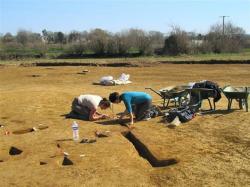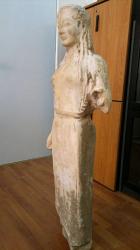INSTITUT SUPERIEUR D'ANTHROPOLOGIE
INSTITUTE OF ANTHROPOLOGY
ONLINE COURSES / COURS A DISTANCE
INSCRIPTION 2012 / Session II : Avril 2012
REGISTRATION 2012 / Term II : April 2012
TAIWAN –  Taichung - Three human skeletons were recently unearthed at the Chung-she archaeological site in Taichung City, a finding that a local archaeologist described Monday as a significant archaeological discovery. One of the skeletons dates back to about 1,000 years, in the late stage of the Fanzaiyuan culture, according to archaeologist Liu Yi-chang, a researcher at Academia Sinica's Institute of History and Philology. The skeleton is believed to be that of a middle-aged female, 162 cm to 163 cm in height, he said. It was found face down with both arms behind the back. The other two skeletons have not yet been completely analyzed, he said. artifacts as possible before the site is covered in concrete. The archaeological team has also unearthed pottery and agate pieces at the site that dates back 1,800 years. An entire village, complete with drainage system and stilt houses, has been unearthed as well, he said. drainage system and stilt houses, has been unearthed as well, he said. The Chung-she archaeological site, uncovered in 1997, contains evidence of multiple cultures and is spread over an area of around 1 million square meters. However, only 250,000 square meters have been registered by the city government as a historical site.
Taichung - Three human skeletons were recently unearthed at the Chung-she archaeological site in Taichung City, a finding that a local archaeologist described Monday as a significant archaeological discovery. One of the skeletons dates back to about 1,000 years, in the late stage of the Fanzaiyuan culture, according to archaeologist Liu Yi-chang, a researcher at Academia Sinica's Institute of History and Philology. The skeleton is believed to be that of a middle-aged female, 162 cm to 163 cm in height, he said. It was found face down with both arms behind the back. The other two skeletons have not yet been completely analyzed, he said. artifacts as possible before the site is covered in concrete. The archaeological team has also unearthed pottery and agate pieces at the site that dates back 1,800 years. An entire village, complete with drainage system and stilt houses, has been unearthed as well, he said. drainage system and stilt houses, has been unearthed as well, he said. The Chung-she archaeological site, uncovered in 1997, contains evidence of multiple cultures and is spread over an area of around 1 million square meters. However, only 250,000 square meters have been registered by the city government as a historical site.
http://focustaiwan.tw/ShowNews/WebNews_Detail.aspx?Type=aEDU&ID=201203270042
FRANCE –  Carhaix - Des fouilles archéologiques menées depuis le 5 mars sur la zone d’activités de Kergorvo viennent de révéler la présence d’habitations bien avant la période gallo-romaine. Les huit archéologues de l’agence rennaise Eveha ont en effet découvert les contours d’une habitation en forme d’amande, « une forme inédite, dont on n’a pas d’autre exemple, si ce n’est en Angleterre », précise Sébastien Toron, responsable d’opération. De quoi laisser supposer l’existence d’« un petit village chalcolithique, c’est-à-dire du tout début de l’Âge de bronze, environ 2 400 ans avant J.-C. » Soit près de 2 000 ans avant l’aqueduc gallo-romain… Plusieurs foyers de pierres, « probablement des fours culinaires, car on a retrouvé des outils en silex et un fragment céramique très spécifique, avec des petits triangles incisés dans la pâte avant la cuisson, qui correspond à l’époque du bâtiment », ont également été découverts sur ce site d’un hectare, destiné à accueillir l’extension de la zone d’activités carhaisienne.
Carhaix - Des fouilles archéologiques menées depuis le 5 mars sur la zone d’activités de Kergorvo viennent de révéler la présence d’habitations bien avant la période gallo-romaine. Les huit archéologues de l’agence rennaise Eveha ont en effet découvert les contours d’une habitation en forme d’amande, « une forme inédite, dont on n’a pas d’autre exemple, si ce n’est en Angleterre », précise Sébastien Toron, responsable d’opération. De quoi laisser supposer l’existence d’« un petit village chalcolithique, c’est-à-dire du tout début de l’Âge de bronze, environ 2 400 ans avant J.-C. » Soit près de 2 000 ans avant l’aqueduc gallo-romain… Plusieurs foyers de pierres, « probablement des fours culinaires, car on a retrouvé des outils en silex et un fragment céramique très spécifique, avec des petits triangles incisés dans la pâte avant la cuisson, qui correspond à l’époque du bâtiment », ont également été découverts sur ce site d’un hectare, destiné à accueillir l’extension de la zone d’activités carhaisienne.
http://www.ouest-france.fr/actu/actuLocale_-Carhaix.-La-cite-gallo-romaine-habitee-des-l-%C3%83%E2%80%9Age-de-bronze-_40820-2060085------29232-aud_actu.Htm
GRECE –  Fyli - Greek police recovered an ancient statue that was illegally excavated and hidden in a goat pen near Athens, and arrested the goat herder and another man who were allegedly trying to sell the work for €500,000 ($667,000). The marble statue of a young woman dates to about 520 BC and belongs to the kore type, a police statement said Wednesday. Police photos showed the 1.2-metre work to be largely intact, lacking the left forearm and plinth. Although dozens of examples of the kore statue and its male equivalent, the kouros, are displayed in Greek and foreign museums, the type is considered very important in the development and understanding of Greek art. Detectives are seeking to determine where the statue was excavated, which could potentially lead archaeologists to a previously unknown 6th century BC sanctuary or cemetery.
Fyli - Greek police recovered an ancient statue that was illegally excavated and hidden in a goat pen near Athens, and arrested the goat herder and another man who were allegedly trying to sell the work for €500,000 ($667,000). The marble statue of a young woman dates to about 520 BC and belongs to the kore type, a police statement said Wednesday. Police photos showed the 1.2-metre work to be largely intact, lacking the left forearm and plinth. Although dozens of examples of the kore statue and its male equivalent, the kouros, are displayed in Greek and foreign museums, the type is considered very important in the development and understanding of Greek art. Detectives are seeking to determine where the statue was excavated, which could potentially lead archaeologists to a previously unknown 6th century BC sanctuary or cemetery.
http://www.thestar.com/news/world/article/1152988--priceless-ancient-greek-statue-rescued-from-goat-pen-goatherd-arrested
FRANCE –  Saint-Amand-les-Eaux - À Saint-Amand-les-Eaux, huit années d'un chantier monumental viennent de s'achever sur une restauration remarquable : délivrée de ses derniers échafaudages, la Tour abbatiale construite au XVIIe siècle par l'abbé Nicolas Dubois, devenue au fil du temps l'emblème de la cité thermale, apparaît désormais dans tout son éclat. Une aventure dont le point culminant, le moment le plus spectaculaire, fut la réouverture de la perspective, dans la façade principale : « Une vraie découverte du chantier, une découverte archéologique, qui s'est prolongée par l'achèvement du projet de l'architecte d'origine », rappelait hier Luc Pelletier.
Saint-Amand-les-Eaux - À Saint-Amand-les-Eaux, huit années d'un chantier monumental viennent de s'achever sur une restauration remarquable : délivrée de ses derniers échafaudages, la Tour abbatiale construite au XVIIe siècle par l'abbé Nicolas Dubois, devenue au fil du temps l'emblème de la cité thermale, apparaît désormais dans tout son éclat. Une aventure dont le point culminant, le moment le plus spectaculaire, fut la réouverture de la perspective, dans la façade principale : « Une vraie découverte du chantier, une découverte archéologique, qui s'est prolongée par l'achèvement du projet de l'architecte d'origine », rappelait hier Luc Pelletier.
http://www.lavoixdunord.fr/Locales/Valenciennes/actualite/Valenciennes/2012/03/28/article_la-tour-abbatiale-de-saint-amand-un-chef.shtml
PAKISTAN –  Abbottabad - For at least two-and-a-half centuries, Masjid Sehr, an architectural gem of masterful woodwork and stone-cutting, stood surrounded by pine trees on a hillock in a remote village in the Nagri Totial area of Abbottabad. Then it was destroyed. The cause was not sectarian hatred, natural disaster or accidental fire. Rather, there were simply too many people in the village who wanted to pray. The beautiful old mosque could not hold them all. In our functional times, the village elders came together in a Jirga and decided unanimously to demolish the historic mosque. A new one is being built on the site.
Abbottabad - For at least two-and-a-half centuries, Masjid Sehr, an architectural gem of masterful woodwork and stone-cutting, stood surrounded by pine trees on a hillock in a remote village in the Nagri Totial area of Abbottabad. Then it was destroyed. The cause was not sectarian hatred, natural disaster or accidental fire. Rather, there were simply too many people in the village who wanted to pray. The beautiful old mosque could not hold them all. In our functional times, the village elders came together in a Jirga and decided unanimously to demolish the historic mosque. A new one is being built on the site.
http://tribune.com.pk/story/356264/bulldozing-beauty-250-year-old-mosque-falls-victim-to-philistinism/
FRANCE –  Alésia - De nouveaux regards sur l’acculturation des Gaules, à l’occasion de l’ouverture du centre d’interprétation d’Alésia et de l’Année Archéologique en Bourgogne. 52 avant Jésus-Christ, fin de l’été. Jules César bat en retraite après avoir été repoussé devant Gergovie. A peine ses troupes sont-elles réunies entre la Loire et l’Yonne qu’il est attaqué par Vercingétorix, et oblige finalement le chef gaulois à se replier sur l’oppidum d’Alésia – l’actuelle Alise-Sainte-Reine –, une place forte située à une soixantaine de kilomètres au nord-ouest de Dijon. Au terme du combat qui oppose plusieurs centaines de milliers d’hommes, les Gaulois sont contraints de s’incliner. Vercingétorix se rend à César, la Gaule s’apprête à devenir romaine… L’histoire qui suit a toujours été représentée comme un processus permettant à un monde celtique « archaïque et barbare » d’accéder à un degré « supérieur » de civilisation. Cette approche est aujourd’hui profondément remise en question par les archéologues et les historiens qui scrutent les transformations des Gaules sous l’emprise romaine.
Alésia - De nouveaux regards sur l’acculturation des Gaules, à l’occasion de l’ouverture du centre d’interprétation d’Alésia et de l’Année Archéologique en Bourgogne. 52 avant Jésus-Christ, fin de l’été. Jules César bat en retraite après avoir été repoussé devant Gergovie. A peine ses troupes sont-elles réunies entre la Loire et l’Yonne qu’il est attaqué par Vercingétorix, et oblige finalement le chef gaulois à se replier sur l’oppidum d’Alésia – l’actuelle Alise-Sainte-Reine –, une place forte située à une soixantaine de kilomètres au nord-ouest de Dijon. Au terme du combat qui oppose plusieurs centaines de milliers d’hommes, les Gaulois sont contraints de s’incliner. Vercingétorix se rend à César, la Gaule s’apprête à devenir romaine… L’histoire qui suit a toujours été représentée comme un processus permettant à un monde celtique « archaïque et barbare » d’accéder à un degré « supérieur » de civilisation. Cette approche est aujourd’hui profondément remise en question par les archéologues et les historiens qui scrutent les transformations des Gaules sous l’emprise romaine.
http://www.franceculture.fr/emission-tout-un-monde-alesia-apres%E2%80%A6-nouveaux-regards-sur-l%E2%80%99acculturation-des-gaules-2012-03-27